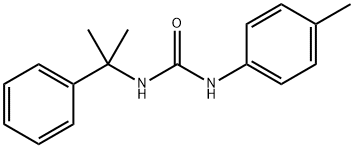|
|
| Product Name: | DYMRON | | Synonyms: | dymrone;k223;n-(4-methylphenyl)-n’-(1-methyl-1-phenylethyl)-ure;n-(4-methylphenyl)-n’-(1-methyl-1-phenylethyl)urea;n-(alpha,alpha-dimethylbenzyl)-n(sup1)-p-tolylurea;shouron;DYMRON;DAIMURON | | CAS: | 42609-52-9 | | MF: | C17H20N2O | | MW: | 268.35 | | EINECS: | | | Product Categories: | | | Mol File: | 42609-52-9.mol |  |
| | DYMRON Chemical Properties |
| Melting point | 201~206℃ | | Boiling point | 411.52°C (rough estimate) | | density | 1.0208 (rough estimate) | | refractive index | 1.5486 (estimate) | | storage temp. | 0-6°C | | pka | 13.52±0.46(Predicted) |
| Toxicity | The acute oral LD50 of male rats is 4000mg/kg and that of male mice is 6500mg/kg; the acute percutaneous LD50 of rats and mice is about 3500mg/kg . No teratogenic, carcinogenic or mutagenic effects were found in chronic toxicity tests. Carp LC50 was 300mg/L (48h). |
| | DYMRON Usage And Synthesis |
| Chemical Properties | White needle crystal. mp203°C. The solubility at 20°C is: methanol, ethanol 1%, acetone, ether 10%, dimethylformamide 18.2%, dimethyl sulfoxide 20%, insoluble in water. It is stable in the range of pH 2~10 and under heating and ultraviolet light irradiation, and can be hydrolyzed by boiling in 1mol/L hydrochloric acid for 6h. | | Uses | Daimuron is a new substituted urea herbicides,it is absorbed by the roots of plants, which can significantly inhibit the elongation of roots and underground stems, so as to control the growth of the above-ground parts.It has special effects on sedge weeds, and can safely control the special-shaped weeds, triangular grasses, and cow hair grasses of crops such as rice, cotton, corn, soybeans, etc., with good results. | | Definition | ChEBI: Daimuron is a member of ureas. | | Synthesis | Synthesis of daimuron:Add 0.15 mol of p-tolylurea, 0.1 mol of cumene chloride, 48 g of α-methylstyrene and 160 g of acetonitrile, stir and react at 40°C for 6 hours, let stand at room temperature, separate 32 g of crystals, and yield 80%. |
| | DYMRON Preparation Products And Raw materials |
|